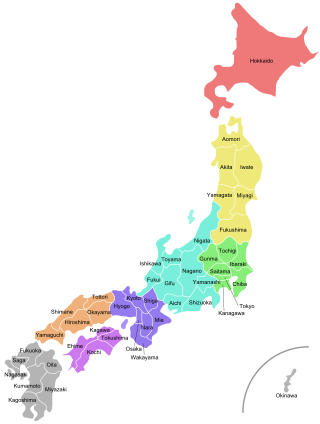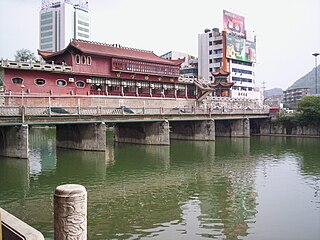
Japan is divided into 47 prefectures,which rank immediately below the national government and form the country's first level of jurisdiction and administrative division. They include 43 prefectures proper,two urban prefectures,one "circuit" or "territory" and one metropolis. In 1868,the Meiji Fuhanken sanchisei administration created the first prefectures to replace the urban and rural administrators in the parts of the country previously controlled directly by the shogunate and a few territories of rebels/shogunate loyalists who had not submitted to the new government such as Aizu/Wakamatsu. In 1871,all remaining feudal domains (han) were also transformed into prefectures,so that prefectures subdivided the whole country. In several waves of territorial consolidation,today's 47 prefectures were formed by the turn of the century. In many instances,these are contiguous with the ancient ritsuryōprovinces of Japan.

A prefecture-level city or prefectural city is an administrative division of the People's Republic of China (PRC),ranking below a province and above a county in China's administrative structure.

Vehicle registration plates in China are mandatory metal or plastic plates attached to motor vehicles in mainland China for official identification purposes. The plates are issued by the local traffic management offices,which are sub-branches of local public security bureaus,under the rules of the Ministry of Public Security.

Xiangxi Tujia and Miao Autonomous Prefecture is an autonomous prefecture of the People's Republic of China. It is located in northwestern Hunan province. It consists of one city,Jishou,and seven counties:Baojing,Fenghuang,Guzhang,Huayuan,Longshan,Luxi,and Yongshun. Jishou is the capital. Of the 2,480,000 residents,66.6% are ethnic minorities from 25 different ethnic groups,including 860,000 Tujia and 790,000 Miao.

Meishan (Chinese:眉山;Sichuanese Pinyin:Mi2san1;local pronunciation:[mi˨˩sã˥];pinyin:Méishān;Wade–Giles:Mei-shan),formerly known as Meizhou (眉州) or Qingzhou (青州),is a prefecture-level city with 2,955,219 inhabitants as of 2020 census whom 1,232,648 lived in the built-up (or metro) area made of the 2 urban districts of Dongpo and Pengshan. Its located in Sichuan province,China. Meishan is in the southwest of Sichuan Basin.

The Daxia River is a tributary of the Yellow River in southern Gansu Province in China's west.

Nùjiāng Lisu Autonomous Prefecture is an autonomous prefecture of western/northwestern Yunnan province,People's Republic of China.

Dali Bai Autonomous Prefecture is an autonomous prefecture of northwestern Yunnan Province,People's Republic of China. Dali has an area of 29,460 square kilometres (11,370 sq mi) and its seat is located in Xiaguan,Dali City.

Qiandongnan Miao and Dong Autonomous Prefecture,also known as Southeast Qian Autonomous Prefecture of Miao and Dong and shortened as S.E. Qian Prefecture,is an autonomous prefecture in the southeast of Guizhou province in the People's Republic of China,bordering Hunan to the east and Guangxi to the south. The seat of the prefecture is Kaili. Qiandongnan has an area of 30,337 km2 (11,713 sq mi).

Qiannan Buyei and Miao Autonomous Prefecture is an autonomous prefecture of Guizhou province,People's Republic of China,bordering Guangxi to the south. The prefecture's seat is Duyun,while its area is 26,192 km2 (10,113 sq mi). The name "黔南" derives from the prefecture's south-central location in the province;"黔" is the official abbreviation for Guizhou,while "南" means "south".

Qianxinan Buyei and Miao Autonomous Prefecture,is an autonomous prefecture of Guizhou province,People's Republic of China,bordering Guangxi to the south and Yunnan to the west. The name,"黔西南" derives from the prefecture's southwest location in the province;"黔" is the official abbreviation for Guizhou,while "西南" means "southwest".

Ningguo is a county-level city in the southeast of Anhui province,People's Republic of China,under the administration of Xuancheng City and bordering Zhejiang province to the south and east. It has a population of 380,000 and an area of 2,447 km2 (945 sq mi).
The Qingtian dialect is a dialect of the Chinese language. It is spoken in Qingtian county of Lishui prefecture in Zhejiang,China. The Qingtian dialect is one of the Chuqu dialects of Wu Chinese spoken in Quzhou and Lishui prefectures of Zhejiang.

Xinyi,alternately romanized as Sunyi,is a county-level city in Guangdong Province,China. It is administered as part of the prefecture-level city of Maoming in the southwestern corner of the province,bordering Guangxi to the west. As of the 2020 census,it had a population of 1,014,577 people. Though its metro area is much smaller with 418,731 inhabitants considered urban.

Hotan Prefecture is located in the Tarim Basin region of southwestern Xinjiang,China,bordering the Tibet Autonomous Region to the south and Union Territory of Ladakh and Gilgit-Baltistan to the west. The vast majority of the Aksai Chin region which is disputed between China and India is administered as part of Hotan Prefecture. The seat of Hotan Prefecture is Hotan and its largest county by population is Karakax County. The vast majority of the residents of the prefecture are Muslim Uyghurs and live around oases situated between the desolate Taklamakan Desert and Kunlun Mountains.

Daxing'anling Prefecture,also known as Da Hinggan Ling Prefecture,is the northernmost Chinese prefecture-level division,located in northwestern Heilongjiang Province. It covers 46,755 km2 (18,052 sq mi) and had a population of 520,000,as of 2004. It is named after the Greater Khingan Range Mountains. In 2007,it had a GDP of RMB 6.1 billion and a growth rate of 11.1%. In 2015,Daxing'anling Prefecture had a GDP of RMB 13.49 billion,and a GDP of RMB 15.39 billion in the year 2014.
Chu–Qu Wu is a Southern Wu Chinese language spoken in Southern Zhejiang in Quzhou and Lishui prefectures,as well as some parts of Southern Wenzhou prefecture. It is also spoken in Shangrao and Yushan counties in Jiangxi province,and the northern part of Ningde and Nanping prefectures in Fujian province bordering Zhejiang. It is not mutually intelligible with Taihu Wu.
Dawu County,also written Tawu County or Daofu County,is a county of northwestern Sichuan Province,China. It is under the administration of the GarzêTibetan Autonomous Prefecture,and as of 2001,had a population of 46,900 residing in an area of 7,546 square kilometres (2,914 sq mi). By road it is 219 km (136 mi) from Kangding,the prefectural seat,and 585 km (364 mi) from Chengdu,the provincial capital. It borders the counties of Xinlong to the west,Kangding and Yajiang to the south,and Jinchuan and Zamtang of Ngawa Prefecture as well as Luhuo to the north.

Dayi County is a county of Sichuan Province,China,it is under the administration of the prefecture-level city of Chengdu,the provincial capital. It is Chengdu City's westernmost division,bordering the prefecture-level divisions of Ya'an to the south and the Ngawa Tibetan and Qiang Autonomous Prefecture to the north.
Yizhou or Yi Prefecture (宜州) was a zhou (prefecture) in imperial China centering on modern Yizhou,Guangxi,China. It existed (intermittently) from the late 660s to 1265.
















